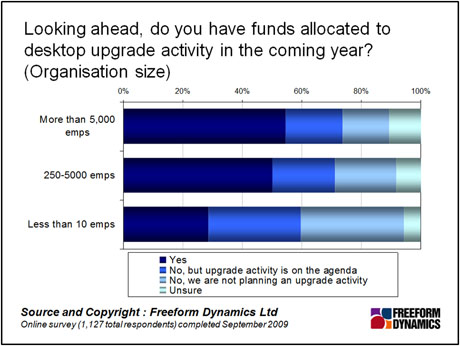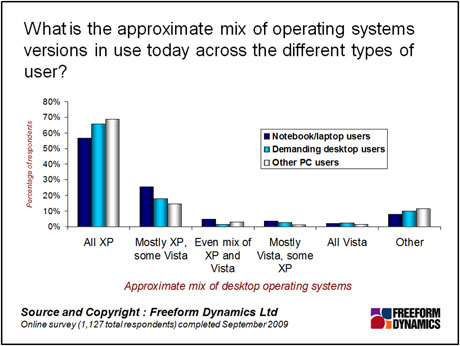Migrating desktops is never easy. The promise of better management and security that is offered by desktop virtualisation is adding a new twist to the many desktop migration projects that are beginning to show themselves.
In this article we look at what, if anything, that we have done in the past can be applied in a “traditional desktop to virtual desktop” migration scenario, and highlight any potential gaps and gotchas that organisations should watch out for if they are considering implementing desktop virtualisation in any of its guises.
Figure 1 below highlights that many organisations are today actively looking at refreshing their desktop estates. Indeed, it is fair to say that the majority of organisations expect to undertake some form of desktop upgrade or refresh activity in the very near term, if they haven’t just done it already.

This drive towards upgrading or refreshing desktop and laptop estates is by no means unexpected. We know from our research
that the age of much of the desktop machine population now exceeds three years, and that many organisations face considerable challenges maintaining the effectiveness of this ageing kit in terms of meeting business needs.
As important are the challenges in maintaining user satisfaction as the age of kit increases, which can in turn so easily lead to a poor perception of IT in general given that desktop equipment is one of the few parts of the infrastructure that every user physically touches.
With desktop upgrade activity now gathering pace, it is best to think about the options from the perspective of where these journeys are likely to begin, rather than leaping immediately to where they could end. A quick glance at Figure 2 indicates the state of play when we last checked with respect to desktop operating systems, for example.
The report referred to in the link above makes the point that some organisations are not only looking at deploying the latest Microsoft desktop operating system, Windows 7, but also potentially Apple systems and even some Linux on the desktop. However, existing operating system and application dependencies need to be considered carefully when planning for a new target operating system or systems.

As indicated in an earlier article in this series, our research also indicates that organisations may not only be looking at the usual “like for like” desktop upgrade and refresh projects. It is clear that many are also considering desktop virtualisation solutions to deploy new desktop services, whatever the underlying physical hardware and operating systems on the target device.
So what are the “gotchas”, especially if considering a migration to a virtual desktop solution?
Many of the hurdles are just the same as for any desktop upgrade project. A major challenge, for example, is identifying exactly how many machines need to be upgraded, which applications need to be installed or updated, and which users will be affected. This sounds simple in principle, but we know from several studies that few organisations have the necessary inventory and asset management information to hand, making the tasks non-trivial in practice.
We’ve also been learning lessons from early adopters of virtual desktop solutions. For a start, getting server and storage systems operating effectively to deliver good performance is vital and the ongoing network configuration and management can be taxing unless good tools and networking expertise are available.
Despite the fact that many desktop virtualisation projects struggle to make a business case that will be accepted by the ultimate business sponsors, it remains important to take the trouble to architect the solution and ensure that best practices (especially around storage configuration and gold imaging) will be followed. As everyone knows, poor performance of any new system is certain to generate extremely negative user feedback in double-quick time.
After this, and as with desktop migrations in general, it is fundamentally a matter of training users and support staff adequately in the new systems in order to ensure smooth running and to minimise the number of support calls generated. A last step is to make sure that good operational processes are put in place to keep the virtual desktop system running, hopefully over many years of active deployment.
We would appreciate any examples you have of tips that helped you get through your projects – if you have any horror stories, we’d like to hear them as well.